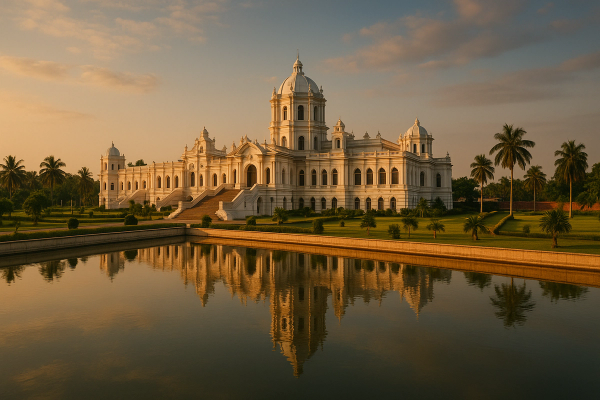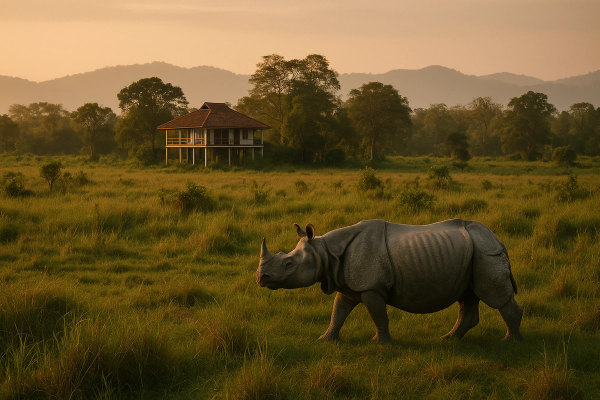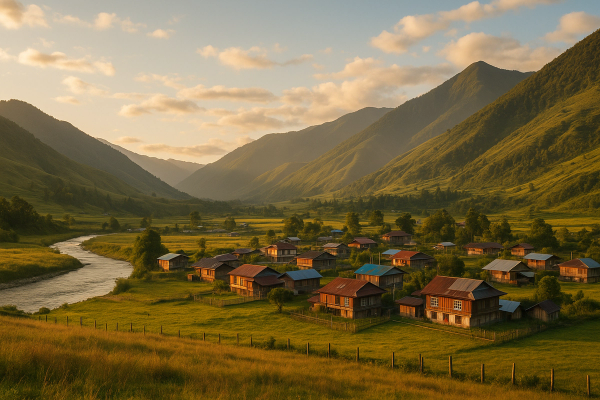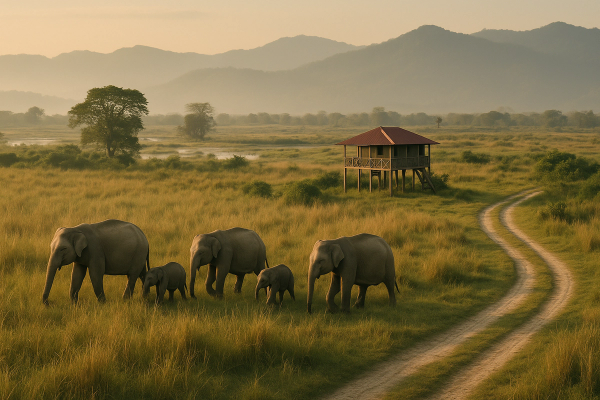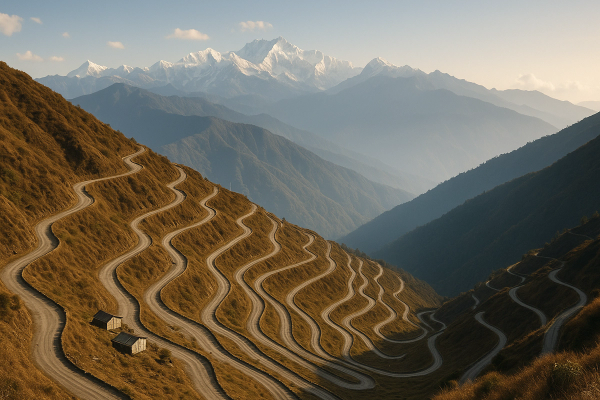
Forget Paris, Choose Paradise: An Offbeat Honeymoon in Northeast India Exploring Meghalaya's Living Root Bridges#
Picture this: Instead of jostling crowds and predictable cityscapes for your honeymoon, you're hand-in-hand, trekking through emerald rainforests, the air thick with the scent of damp earth and exotic blooms. Mist clings to ancient trees, and the only sounds are the symphony of chirping insects, cascading waterfalls, and your own breathing. You cross bridges not made of steel or concrete, but woven from the living roots of ancient trees. Sound like a fairytale? Welcome to Meghalaya, the 'Abode of the Clouds,' and the heart of an unforgettable offbeat honeymoon in Northeast India, centered around its incredible living root bridges.¶
If you're a couple who craves adventure over all-inclusive resorts, connection over commercialism, and authentic experiences over fleeting trends, then Meghalaya is calling. My partner and I sought exactly this – a honeymoon that felt uniquely ours, challenging yet rewarding, steeped in natural beauty and fascinating culture. Our journey to the living root bridges, particularly the famed Double Decker bridge near Nongriat village, was the soul-stirring adventure we dreamed of. This guide shares everything you need to plan your own magical escape.¶
Forget the clichés. This is about forging memories in one of the most unique, bio-engineered marvels on the planet, deep within the lush Khasi hills.
Meghalaya: A Glimpse into the Abode of the Clouds#
Nestled in the northeastern corner of India, Meghalaya is a world apart. Known for its staggering rainfall (holding records for the wettest places on Earth!), this translates into landscapes of dramatic gorges, countless waterfalls, mysterious caves, and unbelievably green hills. It's predominantly home to the Khasi, Jaintia, and Garo tribal communities, with the Khasi people, known for their unique matrilineal society, being the ingenious creators of the living root bridges.¶
These aren't just bridges; they are living, breathing examples of incredible indigenous knowledge and sustainable architecture. For generations, the Khasi people have guided the aerial roots of the Ficus elastica (rubber fig) tree across rivers and streams, patiently weaving and nurturing them until they form strong, functional bridges. Some are centuries old, constantly growing and strengthening over time. It's a testament to living in harmony with nature.¶
When to Visit Meghalaya: Chasing Waterfalls or Sunshine?#
Choosing the best time for your Meghalaya honeymoon depends on your priorities. The weather dramatically shapes the experience, especially the trek to the root bridges.¶
Monsoon Magic (June - September)#
Meghalaya truly lives up to its 'Abode of the Clouds' name during the monsoon. Waterfalls are thunderous, the landscape is intensely green, and clouds often engulf the hills. However, trekking becomes significantly more challenging. Paths are slippery, leeches are common, and the sheer volume of rain can sometimes cause disruptions.¶
- Pro: Witness Meghalaya at its most dramatic and lush; fewer tourists.
- Con: Difficult trekking conditions, potential travel delays, ubiquitous leeches (carry salt/repellent!), some viewpoints might be obscured by fog.
Post-Monsoon Perfection (October - November)#
This is arguably the sweet spot for visiting Meghalaya and trekking to the living root bridges. The rains have subsided, leaving behind vibrant green landscapes, clear skies, and pleasant temperatures. Waterfalls are still impressive from the recent monsoon.¶
- Pro: Ideal weather for trekking, stunning views, waterfalls still flowing well.
- Con: This is peak season, so expect more tourists and potentially higher prices. Book accommodation in advance!
Winter Chill (December - February)#
Winter offers cool, dry weather, making it comfortable for daytime exploration. However, waterfall flow significantly reduces, and mornings/evenings can be quite cold, especially at higher altitudes like Shillong.¶
- Pro: Pleasant, dry weather; good visibility.
- Con: Waterfalls are less spectacular; can get quite cold.
Spring Transition (March - May)#
Temperatures start to rise, and occasional pre-monsoon showers begin, reviving the landscape. It's a good shoulder season with fewer crowds than post-monsoon but potentially more humidity and rain than winter.¶
- Pro: Pleasant temperatures initially, less crowded than peak season.
- Con: Increasing heat and humidity, chance of pre-monsoon showers impacting treks.
Our Pick: We visited in late October, and it was perfect. Crisp air, sunshine, manageable crowds, and the landscape was breathtakingly alive after the rains.
Getting There & Navigating Meghalaya's Hills#
Reaching the heart of Meghalaya involves a multi-stage journey, but the scenic drives are part of the adventure.¶
Flights & Initial Leg#
- By Air: The nearest major airport is Lokpriya Gopinath Bordoloi International Airport (GAU) in Guwahati, Assam. It's well-connected to major Indian cities like Delhi, Kolkata, Mumbai, and Bengaluru. From outside India, you'll likely connect through one of these hubs.
- Guwahati to Shillong: Shillong, the capital of Meghalaya, is about 100 km (approx. 3-4 hours drive) from Guwahati airport. Options include:
- Shared Taxis/Sumos: Cost-effective, readily available outside the airport. Expect a slightly cramped ride.
- Private Taxi: More comfortable and convenient, especially with luggage. Pre-booking or negotiating at the airport taxi stand is possible. Expect costs around ₹2500-₹4000 ($30-$50 USD).
- Helicopter Service: A faster, scenic option (weather permitting) exists between Guwahati and Shillong, though less frequent and more expensive.
Getting Around Meghalaya (Shillong, Cherrapunji, Tyrna)#
Public transport within Meghalaya is limited, especially for reaching tourist spots efficiently. Hiring a vehicle is highly recommended.¶
- Local Taxis: Available in Shillong for city travel. Agree on fares beforehand or use meters if available.
- Hiring a Car & Driver: The most practical option for exploring beyond Shillong (like reaching Cherrapunji/Sohra and the trek starting point). Daily rates vary (approx. ₹3000-₹5000 / $40-$65 USD per day, depending on vehicle type and itinerary). This gives you flexibility and local insights.
- Self-Drive: Possible, but roads can be winding and challenging, especially during monsoon. Ensure you have appropriate permits and are comfortable driving in hilly terrain.
- To the Root Bridges Trek Start (Tyrna Village): From Cherrapunji (Sohra), Tyrna village is the typical starting point for the trek to Nongriat. It's about a 45-60 minute drive. Your hired vehicle will drop you here.
Local Tip: Arrange your multi-day taxi before you arrive or through your Shillong hotel/guesthouse. Reliable drivers are gold here; ask for recommendations! Ensure the driver understands your plan, including the wait time while you trek.
Where to Stay: From City Comforts to Village Homestays#
Accommodation in Meghalaya ranges from comfortable hotels in Shillong to basic but incredibly rewarding homestays in the villages near the root bridges.¶
Shillong#
Meghalaya's capital offers the widest range of options.¶
- Hotels: Mid-range to slightly upscale hotels (e.g., Hotel Polo Towers, Ri Kynjai - Serenity by the Lake (luxury, outside city)). Price Range: ₹3000 - ₹15000+ ($40 - $200+ USD).
- Guesthouses & Homestays: Numerous cozy and often family-run options offer a more personal touch. Price Range: ₹1500 - ₹5000 ($20 - $65 USD).
Cherrapunji (Sohra)#
Staying closer to the trek's starting point is convenient.¶
- Resorts: Several resorts offer stunning valley views (e.g., Polo Orchid Resort, Jiva Resort). Price Range: ₹5000 - ₹15000+ ($65 - $200+ USD).
- Guesthouses & Homestays: Simpler, budget-friendly options are available. Price Range: ₹1000 - ₹4000 ($15 - $50 USD).
Nongriat Village (Near the Double Decker Bridge)#
For the ultimate immersion, stay right in Nongriat village. This requires trekking down with your luggage (pack light!).¶
- Homestays: These are basic, usually offering a room with a mattress, shared bathrooms, and simple home-cooked meals. This is the authentic experience. Examples include Serene Homestay (one of the originals) and several others run by local families. Price Range: ₹500 - ₹1500 ($7 - $20 USD) per person, often including basic meals.
Crucial Advice: Staying in a Nongriat homestay is highly recommended. It allows you to experience the bridges at dawn/dusk without the day-tripper crowds and truly connect with the place. Book well in advance, especially during peak season, as options are limited. Contact numbers can often be found online through travel blogs or Meghalaya tourism resources, but confirming might require persistence.
The Main Event: Trekking to the Living Root Bridges (Nongriat)#
This is the heart of your offbeat honeymoon adventure. The trek to the Jingkieng Nongriat (Double Decker Living Root Bridge) is challenging but incredibly rewarding. It's not just about the destination, but the journey through the jungle.¶
The Starting Point: Tyrna Village#
Your hired vehicle will drop you at Tyrna. Here, you can engage a local guide if you wish (recommended, especially if hiking further to Rainbow Falls, approx. ₹600-₹1000 / $8-$13 USD for the day). There are small shops selling water, snacks, and bamboo hiking sticks (useful!).¶
The Descent: ~3000 Steps Down#
The trek begins with a steep descent down concrete and stone steps. It winds through lush vegetation, small villages, and offers glimpses of the valley.¶
- Time: Allow 1.5 - 2.5 hours for the descent, depending on your fitness level and how often you stop for photos (you will!).
- Highlights En Route: You'll cross a couple of smaller (but still amazing) single living root bridges and some suspension bridges over crystal-clear streams. Take your time, soak it in.
Pace Yourself: The steps are uneven and can be tough on the knees. Don't rush. Remember, you have to climb back up eventually!
Reaching Nongriat Village & The Double Decker Bridge#
After the final set of steps, you'll arrive in Nongriat village. It's a small, peaceful Khasi settlement. Follow the signs (or your guide) for a short walk to the main attraction: the Jingkieng Nongriat, the spectacular Double Decker Living Root Bridge.¶
Seeing it for the first time is breathtaking. Two levels of interwoven living roots span a turquoise river pool. It feels ancient, mystical, and alive. Take your time exploring, walk across both levels (carefully!), and maybe take a refreshing dip in the natural pool below (respect local customs, swimwear is generally fine here but check).¶
Optional Hike: Rainbow Falls#
If you have the energy and time (and ideally stay overnight in Nongriat), consider the further hike to Rainbow Falls. It's another 1.5-2 hours one way from the Double Decker bridge, involving more river crossings and jungle trails.¶
- Reward: A stunning waterfall cascading into a vibrant blue pool. On sunny afternoons, rainbows often form in the mist (hence the name). It's a truly magical spot.
- Note: This section is more rugged than the initial trek. A guide is highly recommended.
The Ascent: The Real Challenge#
The trek back up the ~3000 steps from Nongriat to Tyrna is strenuous. Allow 2-3 hours. Start early if possible, especially if you need to travel back to Shillong the same day. Take plenty of breaks and stay hydrated.¶
Mental Game: The climb is tough, but the sense of accomplishment (and the views) makes it worthwhile. Celebrate reaching the top!
Beyond the Bridges: Other Meghalaya Must-Sees#
While the root bridges are the star, Meghalaya offers more.¶
- Cherrapunji (Sohra) Viewpoints: Visit Nohkalikai Falls (India's tallest plunge waterfall), Seven Sisters Falls (Nohsngithiang Falls), and Mawsmai Cave (an easily accessible limestone cave system).
- Shillong: Explore Ward's Lake, Don Bosco Centre for Indigenous Cultures, Police Bazar (market), and enjoy the vibrant cafe scene.
- Mawlynnong Village: Often dubbed 'Asia's Cleanest Village,' it's picturesque and has another single living root bridge nearby.
- Dawki & Shnongpdeng: Famous for the crystal-clear Umngot River. Go boating and marvel at the riverbed visible below (best in winter months).
- Laitlum Canyons: Offers breathtaking panoramic views of rolling hills and deep gorges near Shillong.
Fueling Your Adventure: Khasi Cuisine & Local Eats#
Meghalayan food is hearty, flavorful, and often features pork, chicken, fish, rice, and unique local ingredients.¶
- Jadoh: A popular Khasi dish of red rice cooked with meat (usually pork) and spices. Different variations exist.
- Dohkhlieh: A flavourful pork salad, often made with onions, chillies, and ginger. Sometimes includes pig's brain (ask if unsure!).
- Tungrymbai: A pungent chutney made from fermented soybeans, a local delicacy.
- Pumaloi: Steamed rice cakes, often eaten for breakfast.
- Nongriat Meals: Expect simple, delicious home-cooked food at the homestays – typically rice, dal (lentils), seasonal vegetables, and maybe eggs or chicken curry.
- Shillong Cafes: Explore cafes like Dylan's Cafe or Cafe Shillong for coffee, snacks, and live music.
Must-Try: Be adventurous and sample local Khasi dishes at small eateries in Shillong or Cherrapunji for an authentic taste. And the simple Maggi noodles prepared at tiny stalls along the trek path somehow taste heavenly after the exertion!
Practical Tips for Your Meghalaya Root Bridge Honeymoon#
A little preparation goes a long way for a smooth trip.¶
Packing Essentials#
- Footwear: Comfortable, sturdy trekking shoes with excellent grip are NON-NEGOTIABLE. Broken-in shoes are best.
- Clothing: Lightweight, quick-drying clothes (synthetics/blends are better than cotton). Layers are key (t-shirts, fleece, light jacket).
- Rain Gear: Essential year-round! A good raincoat/poncho and potentially rain pants. Umbrella.
- Backpack: A comfortable daypack for the trek, and if staying in Nongriat, a larger backpack (not suitcase!) you can carry down.
- First-Aid Kit: Include basics like antiseptic wipes, bandages, pain relievers, blister treatment, any personal medication.
- Insect Repellent: Especially for monsoon/post-monsoon.
- Leech Socks: Highly recommended during monsoon.
- Sun Protection: Sunscreen, hat, sunglasses (sun can be strong between clouds).
- Power Bank: Electricity can be intermittent, especially in villages.
- Cash: ATMs are scarce outside Shillong. Carry enough cash for homestays, food, guides, small purchases.
- Water Bottle/Filter: Stay hydrated. Consider a reusable bottle and purification tablets/filter to reduce plastic waste.
- Headlamp/Torch: Useful in villages with limited lighting and caves.
Budget Considerations#
Meghalaya can be traveled on various budgets. Here’s a rough idea (per person per day, excluding flights):¶
| Budget Level | Accommodation | Food | Transport/Activities | Estimated Daily Cost (INR) | Estimated Daily Cost (USD) |
|---|---|---|---|---|---|
| Budget | Homestays (Nongriat/Sohra), Basic Guesthouses (Shillong) | Local eateries, Homestay meals | Shared taxis (limited), Trekking | ₹1500 - ₹2500 | $20 - $35 |
| Mid-Range | Standard Guesthouses/Hotels (Shillong), Resorts (Sohra) | Mix of local & cafe/restaurant meals | Hired taxi for key days | ₹3500 - ₹6000 | $45 - $80 |
| Comfort/Luxury | Higher-end Hotels/Resorts | Restaurant dining | Dedicated hired vehicle throughout | ₹7000+ | $90+ |
Note: These are estimates. Costs for hired vehicles are usually per car, so sharing reduces per-person cost.¶
Health, Safety & Connectivity#
- Fitness: The trek requires moderate fitness. Be honest about your abilities. The ascent is strenuous.
- Hydration: Drink plenty of water, especially during the trek.
- Slippery Paths: Be extremely cautious on wet steps and rocks.
- Connectivity: Mobile network is patchy outside Shillong, and almost non-existent in Nongriat. Wi-Fi is rare in homestays. Embrace the digital detox!
- Visa (International Travelers): Ensure you have the appropriate Indian visa. Check official Indian government sources for the latest requirements well in advance.
Local Etiquette#
- Respect Culture: Meghalaya has unique tribal cultures. Be respectful, especially in villages.
- Photography: Always ask permission before taking photos of people.
- Dress Modestly: While trekking gear is fine, dress modestly when visiting villages or religious sites.
- Greetings: Learn a basic Khasi greeting: "Khublei" (pronounced Khub-lay) means hello/thank you/goodbye.
Sample 5-Day Meghalaya Root Bridge Honeymoon Itinerary#
This focuses on the root bridge experience.¶
- Day 1: Arrive Guwahati, Transfer to Shillong. Settle into your hotel. Evening stroll around Ward's Lake or explore Police Bazar.
- Day 2: Shillong to Cherrapunji (Sohra). Hire a car. Visit Laitlum Canyons en route (optional detour). In Sohra, see Nohkalikai Falls, Mawsmai Cave, Seven Sisters Falls. Overnight near Sohra.
- Day 3: Trek to Nongriat. Drive to Tyrna village. Begin the trek down (~2 hrs). Check into your pre-booked Nongriat homestay. Explore the Double Decker Living Root Bridge. Relax, swim.
- Day 4: Nongriat Exploration / Trek Back Up. Option 1: Hike to Rainbow Falls (allow 4-5 hours round trip). Option 2: Relax in Nongriat, enjoy the tranquility. Afternoon: Begin the strenuous trek back up to Tyrna (~2-3 hrs). Meet your driver, return to Sohra or Shillong for the night.
- Day 5: Cherrapunji/Shillong to Guwahati, Depart. Depending on flight schedule, visit any missed spots or drive directly back to Guwahati airport (allow 4-5 hours travel time from Shillong, 5-6 hours from Sohra).
Traveling Responsibly in Meghalaya#
Meghalaya's beauty is fragile. As visitors, we have a responsibility to protect it.¶
- Leave No Trace: Pack out everything you pack in. Do not litter. Use designated bins where available.
- Respect the Bridges: These are living structures. Do not pull on roots or leaves. Walk gently.
- Support Local Communities: Stay in homestays, hire local guides, buy local crafts (responsibly). Your tourism directly benefits the people preserving these wonders.
- Minimize Plastic: Carry reusable water bottles and refuse single-use plastics where possible.
- Water Usage: Be mindful of water consumption, especially in villages where resources might be limited.
Remember: The living root bridges are a legacy. Let's ensure future generations can marvel at them too.
Final Thoughts: Is an Offbeat Meghalaya Honeymoon Right for You?#
If your idea of romance involves shared challenges, breathtaking natural beauty untouched by mass tourism, and authentic cultural immersion, then absolutely YES. An offbeat honeymoon in Northeast India exploring Meghalaya's living root bridges isn't about luxury in the traditional sense; it's about the luxury of experience, connection, and discovering a truly magical corner of the world together.¶
It pushes you physically, rewards you spiritually, and leaves you with stories you'll recount for a lifetime. Standing on that Double Decker bridge, listening to the river flow beneath roots woven together over decades, is a profound moment – a perfect metaphor for the beginning of a shared life, nurtured patiently and growing stronger together. It was, for us, the most incredible start to our married life.¶
Ready for your own Meghalaya adventure? Have you visited the living root bridges or dreaming of an offbeat honeymoon? Share your thoughts or questions in the comments below! For more travel inspiration, check out other travel guides.¶






